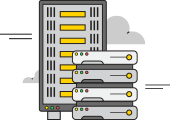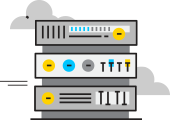Introduction
A Host Virtual Machine (VM) is a software emulation of a physical computer, allowing multiple operating systems (OS) to run simultaneously on a single physical server. It is a key component in modern virtualization technologies, enabling efficient resource utilization, isolation, and flexibility in server environments. Host VMs play a crucial role in the operation of proxy server providers like OneProxy (oneproxy.pro) by offering a reliable and scalable infrastructure.
History and Early Mention
The concept of virtual machines dates back to the 1960s when researchers at IBM developed the CP-40 and CP-67 operating systems, introducing the idea of “virtual machines.” However, it was not until the 2000s that VMs gained widespread popularity due to advancements in hardware virtualization technologies. VMWare, a major player in the virtualization space, pioneered x86 virtualization, making VMs accessible to a broader audience. Since then, other platforms like Microsoft Hyper-V, KVM, and Xen have emerged, providing users with various options for deploying VMs.
Detailed Information about Host Virtual Machine
A Host Virtual Machine is a software-based abstraction of a physical server, known as the “host.” The host machine utilizes a hypervisor, a specialized software layer responsible for managing and allocating the hardware resources to multiple VMs. The hypervisor creates and runs these VMs, allowing them to act as independent systems with their own virtual hardware, including CPUs, memory, storage, and network interfaces.
Internal Structure and Functioning
The Host VM environment consists of three primary layers:
-
Hardware Layer: The physical hardware of the host machine, including the CPU, RAM, storage devices, and network interfaces.
-
Hypervisor Layer: The hypervisor is responsible for virtualizing the hardware resources and managing the VMs. There are two types of hypervisors:
- Type 1 (Bare-metal): Installed directly on the physical hardware, providing superior performance and efficiency. Examples include VMWare ESXi, Microsoft Hyper-V, and KVM.
- Type 2 (Hosted): Installed on top of a host OS, suitable for desktop virtualization. Examples include VMWare Workstation and Oracle VirtualBox.
-
Virtual Machine Layer: This layer comprises multiple VMs, each running an independent guest OS. The guest OS interacts with the virtual hardware provided by the hypervisor and runs applications as if it were running on a physical machine.
Key Features of Host Virtual Machine
The Host VM technology offers several key features, making it a popular choice for organizations:
-
Isolation: Each VM operates independently of others, providing strong isolation between applications and operating systems. This isolation ensures that a failure in one VM does not affect others.
-
Resource Allocation: The hypervisor efficiently allocates resources like CPU, memory, and storage among VMs, ensuring fair sharing and optimal utilization of hardware.
-
Snapshot and Cloning: VMs can be easily replicated through snapshots and cloning, allowing for quick backups, testing, and deployment of new instances.
-
Migration: Live migration enables VMs to be moved between physical hosts with minimal downtime, ensuring load balancing and improved fault tolerance.
-
Hardware Abstraction: VMs are not tied to specific hardware, providing flexibility in managing and upgrading the underlying infrastructure.
Types of Host Virtual Machine
Host VMs can be categorized based on their usage and architecture. The following table illustrates some common types:
| Type | Description |
|---|---|
| Server Virtualization | Used in data centers and cloud environments for servers. |
| Desktop Virtualization | Enables virtual desktop infrastructure (VDI) solutions. |
| Application Sandbox | Provides a secure environment for running applications. |
| Testing and Development | Allows developers to test and develop in isolated VMs. |
Uses, Challenges, and Solutions
Host Virtual Machines find applications in various scenarios:
-
Server Consolidation: VMs allow multiple servers to be consolidated into a single physical machine, reducing hardware costs and power consumption.
-
Testing and Development: Developers can create VMs to test software in various environments without affecting the production infrastructure.
-
Legacy Application Support: VMs can host legacy applications that are incompatible with newer operating systems.
-
Disaster Recovery: VM snapshots and replication facilitate efficient disaster recovery strategies.
However, using Host VMs also presents some challenges, such as:
-
Resource Overhead: Running multiple VMs on a single host may lead to resource contention and decreased performance.
-
Security Concerns: Securing VMs and the hypervisor is critical to prevent unauthorized access and data breaches.
-
Backup and Recovery: VM backup and recovery processes must be well-managed to ensure data integrity.
-
Compatibility Issues: Some hardware or software may not work optimally within a virtualized environment.
Addressing these challenges involves employing best practices, such as proper resource planning, security measures, and regular backups.
Characteristics and Comparisons
Here’s a comparison between Host VMs and related virtualization terms:
| Characteristic | Host VM | Container |
|---|---|---|
| Resource Overhead | Slightly higher due to hypervisor | Lower due to shared OS kernel |
| Isolation Level | Strong isolation between VMs | Weaker isolation between containers |
| Deployment Flexibility | High | Lower due to tighter coupling |
| Performance | May suffer from overhead | Higher due to fewer abstractions |
| Use Cases | Diverse (servers, VDI, sandbox) | Lightweight applications and microservices |
Perspectives and Future Technologies
The future of Host Virtual Machines is promising, with ongoing research and developments focusing on:
-
Performance Enhancements: Continued improvements in hardware and hypervisor technology will reduce resource overhead and enhance VM performance.
-
Container Integration: The integration of VMs and containers will provide a balance between strong isolation and lightweight application deployment.
-
Serverless Computing: The rise of serverless architectures may influence how VMs are deployed and managed in cloud environments.
Proxy Servers and Host Virtual Machine
Proxy servers and Host VMs are closely related, especially in the context of proxy server providers like OneProxy. VMs allow proxy providers to scale their infrastructure efficiently, dynamically allocating resources based on demand. Additionally, VMs facilitate the setup and management of multiple proxy instances, each operating independently. This isolation ensures that issues in one proxy server do not impact others, enhancing reliability and performance.




